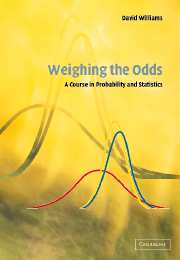Book contents
- Frontmatter
- Contents
- Preface
- 1 Introduction
- 2 Events and Probabilities
- 3 Random Variables, Means and Variances
- 4 Conditioning and Independence
- 5 Generating Functions; and the Central Limit Theorem
- 6 Confidence Intervals for one-parameter models
- 7 Conditional pdfs and multi-parameter Bayesian Statistics
- 8 Linear Models, ANOVA, etc
- 9 Some further Probability
- 10 Quantum Probability and Quantum Computing
- Appendix A Some Prerequisites and Addenda
- Appendix B Discussion of some Selected Exercises
- Appendix C Tables
- Appendix D A small Sample of the Literature
- Bibliography
- Index
10 - Quantum Probability and Quantum Computing
Published online by Cambridge University Press: 05 June 2012
- Frontmatter
- Contents
- Preface
- 1 Introduction
- 2 Events and Probabilities
- 3 Random Variables, Means and Variances
- 4 Conditioning and Independence
- 5 Generating Functions; and the Central Limit Theorem
- 6 Confidence Intervals for one-parameter models
- 7 Conditional pdfs and multi-parameter Bayesian Statistics
- 8 Linear Models, ANOVA, etc
- 9 Some further Probability
- 10 Quantum Probability and Quantum Computing
- Appendix A Some Prerequisites and Addenda
- Appendix B Discussion of some Selected Exercises
- Appendix C Tables
- Appendix D A small Sample of the Literature
- Bibliography
- Index
Summary
The true logic of this world lies in the calculus of probabilities
James Clerk MaxwellAbsolutely right, James Clerk, as always. But which calculus of probabilities? At present, we have two, totally different, calculi: Classical and Quantum. For discussion of the relation between the two calculi, see Subsection 461M.
Please see my thanks to Feynman, Gruska, Isham, Nielsen and Chuang, Penrose, Preskill, …, in Appendix D.
In computer jargon, this chapter is a ‘several-pass’ account: we begin with vague ideas, and tighten these up in stages.
No previous knowledge of Quantum Theory is assumed. Except for a brief discussion of the Uncertainty Principle, we deal exclusively with comparatively easy finite-dimensional situations. We do behave with somewhat greater freedom in our use of Linear Algebra.
I ought to stress the following: Quantum Computing is by no means the most wonderful part of Quantum Theory. If Nature had not chosen to exploit in the design of spin-½ particles the fact that (as we shall see later) ‘SU(2) is the double cover of SO(3)’, then there would be no Chemistry, no Biology, no you!. To a large extent, we are using Quantum Computing as the simplest context in which to learn some Quantum Probability.
My hope is that by the time you finish this chapter, you will be better equipped to read critically the huge amount of ‘popular Science’ (some very good, a lot not so good) on the Uncertainty Principle, entanglement, etc, and that, more importantly, you will be persuaded to learn more from the real experts.
- Type
- Chapter
- Information
- Weighing the OddsA Course in Probability and Statistics, pp. 440 - 494Publisher: Cambridge University PressPrint publication year: 2001



